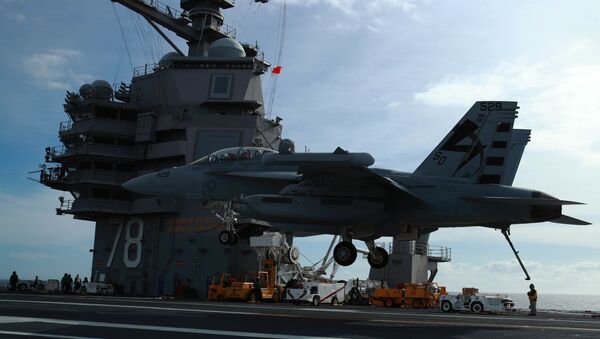The US Navy announced in an April 6 news release that Ford, the lead ship of its aircraft carrier class, recently completed testing of vital combat systems as part of its post-delivery test and trials phase.
“The tests exercise the combat systems suite as a complete unit and ensure maximum availability to meet combat and self-defense mission requirements,” Cmdr. Ron McCallister, the Ford’s combat systems officer, said in the Monday release.
“In the end, the combat systems suite achieves maximum readiness, and the Sailors develop more operational and technical competence.”
McCallister noted that the tests were possible due to a collaborative approach involving the ship’s force, Naval Sea Systems Command and the greater technical community.
The Air Traffic Control Radar Beacon (ATCRB) and Identification of Friend or Foe (IFF) were tested during Ford’s first certification of integrated combat systems. The service detailed that tests of the ATCRB evaluated its ability to use an advanced identification system to track and identify both air and surface contacts as friend or foe. The IFF assists in controlling aircraft and securely identifying a friend.
“We use an interrogator system to challenge aircraft transponders for identification,” explained Operations Specialist 2nd Class Juannietagrace Okeli, of Moss Point, Mississippi. “The interrogator, cooperative engagement capability, and the Ship Self-Defense Systems (SSDS) work together to provide us the combat identification.”
Ford was also able to complete sea-based developmental testing (SBDT) of vital combat systems, which included the carrier’s first full trial of the integrated combat system against tactical adversaries.
“SBDT is a stepping stone towards Ford’s Combat Systems Ship Qualification Trial (CSSQT), and follow-on operational tests by the Navy,” said Cmdr. William Buell, Ford’s Combat Direction Center officer.
During SBDT, sailors in Ford’s combat systems department had to conduct an up-load of simulated munitions for operators in the carrier’s Combat Direction Center to simulate engaging the aircraft.
“Our SBDT operations ran very smoothly, which is a good indicator of future success on CSSQT,” Buell asserted.


